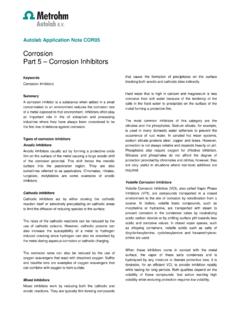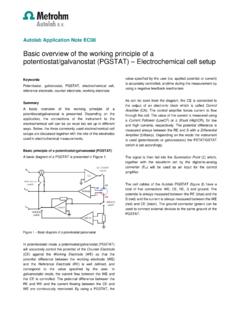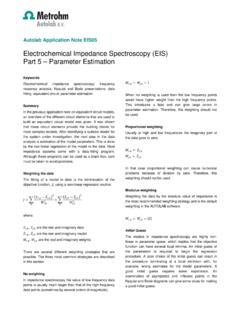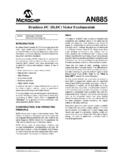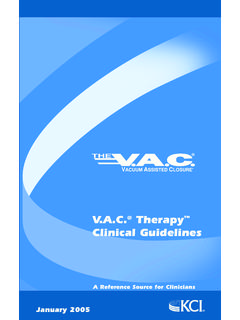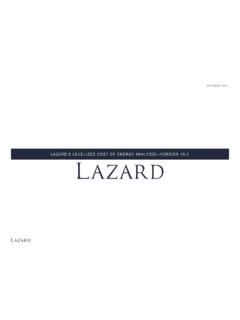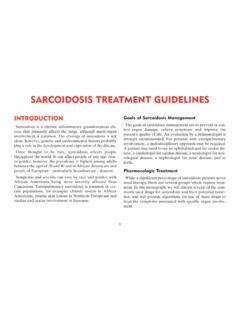Transcription of Galvanostatic Intermittent Titration Technique
1 Autolab Application Note BAT03 Galvanostatic Intermittent Titration Technique Keywords Batteries; Li-ion batteries, Galvanostatic ; Titration ; GITT Summary Lithium-ion (Li-ion) batteries are one of the most investigated energy storage devices, due to their relatively high energy and high power performances. During charge and discharge of a Li-ion battery, lithium ions are transported from one electrode, through the electrolyte, to the other electrode. Here, Li-ion diffusion into the bulk material occurs. In this respect, knowing the chemical diffusion coefficient of electrode materials is of extreme importance.
2 Furthermore, the thermodynamic properties of the electrodes materials can give a better understanding of their electrochemical behavior. The Galvanostatic Intermittent Titration Technique (GITT) is a procedure useful to retrieve both thermodynamics and kinetics parameters [1, 2]. GITT measurements In a typical GITT measurement, a cell composed of metallic lithium (counter and reference electrode), electrolyte and positive (working) electrode is employed. In this way, pieces of information about the thermodynamics of the active material present in the positive electrode can be obtained, together with the diffusion coefficient.
3 The GITT procedure consists of a series of current pulses, each followed by a relaxation time, in which no current passes through the cell. The current is positive during charge and negative during discharge. During a positive current pulse, the cell potential quickly increases to a value proportional to the iR drop, where R is the sum of the uncompensated resistance Run and the charge transfer resistance Rct. Afterwards, the potential slowly increases, due to the Galvanostatic charge pulse, in order to maintain a constant concentration gradient. When the current pulse is interrupted, , during the relaxation time, the composition in the electrode tends to become homogeneous by Li-ions diffusion.
4 Consequently, the potential first suddenly decreases to a value proportional to the iR drop, and then it slowly decreases until the electrode is again in equilibrium ( , when dE/dt ~ 0) and the open circuit potential (Voc) of the cell is reached. Then, the Galvanostatic pulse is applied again, followed by current interruption. This sequence of charge pulse followed by a relaxation time is repeated until the battery is fully charged. During a negative current pulse, the opposite holds. The cell potential quickly decreases to a value proportional to iR. Then, the potential slowly decreases, due to the Galvanostatic discharge pulse.
5 During the relaxation time, the potential suddenly increases by a value proportional to iR, and then it slowly increases, until the electrode is again in equilibrium ( , when dE/dt ~ 0) and the Voc of the cell is reached. Then, the following Galvanostatic pulse is applied, followed by current interruption. This sequence of discharge pulse followed by a relaxation time is repeated until the battery is fully discharged. The chemical diffusion coefficient can be calculated at each step, with the following formula [1-3 ]: = 4 2 2 (1.)
6 1) Here, i is the current (A); Vm is the molar volume of the electrode (cm3/mol); zA is the charge number; F is the Faraday s constant (96485 C/mol); S is the electrode/electrolyte contact area (cm2); dE/d is the slope of the coulometric Titration curve, found by plotting the steady state voltages E (V) measured after each Titration step ; dE/d t is the slope of the linearized plot of the potential E (V) during the current pulse of duration t (s). In Figure 1, the potential plot versus the square root of time of the first positive current pulse is shown.
7 Using the linear regression tool provided in NOVA, information about Et can be obtained from the slopes of the Galvanostatic pulses versus the square root of time [4]. Autolab Application Note BAT03 Galvanostatic Intermittent Titration Technique Figure 1 Potential vs. t plot. In addition, the linear regression line and its equation are shown. If sufficient small currents are applied for short time intervals, so that dE/d t can be considered linear and the coulometric Titration curve can be also considered linear over the composition range involved in that step, Equation can be simplified into: = 4 2 2 (1.)
8 2) Here, is the duration of the current pulse (s); nm is the number of moles (mol); Vm is the molar volume of the electrode (cm3/mol); S is the electrode/electrolyte contact area (cm2); Es is the steady-state voltage change, due to the current pulse and Et is the voltage change during the constant current pulse, eliminating the iR drop. Experimental setup For the experiments, an Autolab PGSTAT302N has been employed, together with a commercial Ah Li-ion battery from Enix Energies, with a nominal voltage of V and a nominal energy of Wh. The NOVA procedure The NOVA GITT procedure consists of Galvanostatic charge pulses, each 10 minutes long, followed by 10 minutes of relaxation time, with no current passing through the cell; from OCP to V.
9 Then, GITT discharge steps are applied. Each step is composed of a 10 minutes discharge pulse followed by 10 minutes of rest, with no current passing through the cell. In order to have sufficiently slow potential changes, a current rate of C/10 has been chosen, either for charge or for discharge. This means that, with such current value, the battery could be completely charged (or discharged) in ten hours in a common Galvanostatic charge/discharge procedure. For the battery under investigation, 220 mA of current is applied for charge, and - 220 mA for discharge.
10 Experimental results Figure 2 shows the complete GITT potential profile. The procedure starts at VOC ~ V. Then, GITT charge pulses are applied; each followed by a relaxation period. Here, it can be noticed the potential drops between the pulses and the relaxation times, and that the overall potential increases until V. After charging, the potential decreases, due to the Galvanostatic discharge pulses, each followed by the relaxation time, until potential of V is reached. Figure 2 Galvanostatic Intermittent Titration curve vs. time The duration of the charge and discharge pulses have been calculated based on a C/10 current rate.
